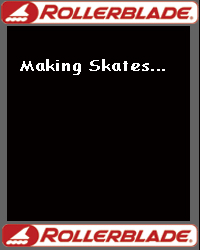 |  |  | ||||||||||||||||||||||||||||||||||||||||||||||||||||||||||||||||||||||||||
| ||||||||||||||||||||||||||||||||||||||||||||||||||||||||||||||||||||||||||||
Part 8: Eddy Matzger Interview ... In Which the Skate Legend Talks About ...
Robert: What's the most valuable advice you have for students? Eddy: That skating is all about balance. It's not a question of what kind of skates you have ... or how strong your legs or ankles are ... or how fit you are: it's about finding your balance. You use your strength when you have to, but otherwise skating is basically about being on vacation, relaxing. And that makes all the difference. If you learn to relax, you save energy for when you really need it. My coach Dianne Holum taught me that a secret to skating fast is being able to skate super, super slowly. When I was training with her, we would have these slow-motion races. And the goal was to be on one skate or the other, not both, at all times. That was one of the most important rules, because skating is about being on one skate or the other, never both at the same time, unless you are coasting down hill. We had to make it look like real skating, just in slow motion. And what we found is if you could skate slowly -- but with perfect form -- and be the last person over the finish line, then you were going to be the fastest skater when you sped up. It's just like what happens when you throw a lump of clay on a pottery wheel. If it isn't perfectly centered, it is going to go all over the place when you press the accelerator. It's a harsh truth to have to stomach, but in order to go fast, you have to learn to go slow. Most people just want to get out there and hammer, instead of learning control and balance. Robert: But it's fun to skate fast. Eddy: It is, but only if you've done your homework. ... If you want to play the Italian Concerto, you have to learn your scales first. Robert: Would you explain the double-push stroke used by inline speedskaters? Eddy: Well, the Dutch invented the double push as a way to skate in the rain. You can't push as long and strong in the rain without losing traction. So the Dutch added a little push underneath the body to compensate. A double push starts as a crossover push and finishes as a regular push. So you actually have two pushes per leg. Robert: Do you feel both pushes separately? Eddy: Yes. Every push requires that you go from a bent to a straight position of your leg. So to do two pushes per leg, you have to straighten twice and bend twice. You start in a bent position, and then you push to a straight position, and then you rebend and do a regular push. It's basically not as complicated as it is made out to be. But there are some basic physical principles that people deny -- such as the fact that you have to have two pushes per stroke. It's not just one carve [pushing out with the back wheels] followed by a push. Your knee-bend angle actually has to change. Ideally, it has to go from 90 degrees to 180 degrees, back to 90 degrees and then back to 180 degrees. If you look at someone like [inline and ice speedskating champion] Chad Hedrick, he'll probably start, not at 90 degrees, but at 105 or 110 degrees. And then his first push is from 110 degrees to 180 degrees, so that's 70 degrees of extension. And then he will reset back to 110 degrees and do a regular push. So instead of 180 degrees of extension per double push, he'll get 130 or 140, which is more than 90. An ideal single push gives you 90 degrees of total extension. So if you can get more than 90 degrees of total push, you have an effective double push. Robert: What about your double push? Do you bend your leg 90 degrees on each of the two pushes? Eddy: No, I do not. I could probably do it for a minute or two, but it would not be effective in the long run? Robert: What would be effective? Eddy: There's an endless variation. Sometimes you need more. For instance, when you are accelerating, you are going to exaggerate and have a bigger double push. Other times, your double push is merely a blip on the radar screen ... almost an afterthought that feeds your regular push with a little initial momentum, which may only involve 20 degrees of extension. Robert: How did you learn the double push? Eddy: I learned it from the Dutch. I tried once to skate behind a guy who was doing a double-push and I just kept falling back out of the draft, because I wasn't able to generate the same speed with just a single push. So after the race, I asked him what he was doing, and he said, "Oh, that was the double push," and he demonstrated a crossover followed by a regular push. Continued ... Part 1|2|3|4|5|6|7|8|9|Next >>>
| Discuss: Talk About this Article ... Or add your own thoughts or stories about Eddy Related Reading | |||||||||||||||||||||||||||||||||||||||||||||||||||||||||||||||||||||||||||
... Copyright © 2006 by Robert Burnson | ||
